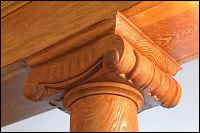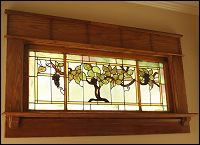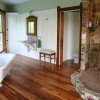
Atlanta Journal-Constitution – Pair’s Vision Enabled Avocation to Build
September 4, 2003
Sandra Eckstein
 Kara O’Brien was thrilled when she found the old, gutted house in the Edgewood section of Atlanta.
Kara O’Brien was thrilled when she found the old, gutted house in the Edgewood section of Atlanta.
“Just the way I like them,” said the house renovator, whose hobby is collecting architectural antiques for her business. Stashed in her basement are old doors, mantels, sinks and tubs, as well as stained glass windows, light fixtures, newel posts and banisters, medicine chests, columns — anything that can be ripped out of old buildings.
O’Brien and her partner, Paula Rose, have been taking on restoration jobs in Atlanta for about six years. The Edgewood 1920 Craftsman bungalow is their latest. Last week, O’Brien counted up the antiques they installed — four mantels, 10 heart-of-pine doors, two 100-year-old craftsman columns, two medicine cabinets, a newel post, a load of bricks, period light fixtures and hardware like doorknobs, hinges and knockers.
“We expect to list it any day for $269,900,” said O’Brien. She and Rose paid $115,000 for the home, then put “a lot of money” into it. “We hope it sells fast because we just bought another house in Cabbagetown.”
 O’Brien and Rose are among homeowners who use old items to give period houses authenticity or new homes a touch of history.
O’Brien and Rose are among homeowners who use old items to give period houses authenticity or new homes a touch of history.
“Anyone who wants their house to be special, to really pop, should look at architectural antiques,” said Julie Silber, who works at Metropolitan Artifacts in Chamblee. Owners Bruce and Emke Cusmano are her parents.
Susan Powers knew from the day she bought her Brookhaven home that she wanted a spectacular front entrance. She found it at Metropolitan Artifacts.
“I wanted two doors, a matched set, that fit in my door area,” said Powers. “They’re walnut on the bottom, decorative iron on top with glass behind the iron. They just make my house.”
Red Baron Antiques in Atlanta is known for its three major annual auctions, which include architectural antiques.
“Items made today have no where near the artistic integrity, the structural quality, of the older things,” said Paul Brown, catalog director for the company. “Things being made today won’t be around to write about in 100 years.”
With Atlanta’s red-hot building market and the move over the past decade toward spending more time at home, people have been looking for ways to make their homes unique. Architectural antiques fit that bill. Businesses who deal in them say the market shows no sign of letting up. And it’s not just big money people shopping for the items. Architectural antiques can be found anywhere from the high-end businesses that deal almost exclusively in them to yard sales, auctions and flea markets. They can cost as little as $5 for an old, wooden window frame to thousands of dollars. At Metropolitan Antiques, doorknobs range from $45 to $1,200. Fireplace mantels can be had for $400 or $20,000. Seven-foot lanterns from a bank in Philadelphia, circa 1900, go for $55,000 each.
“I’ve had things for more than 10 years, waiting for that right person,” said Metropolitan owner Bruce Cusmano, about specialty items.
Today, most of the architectural antiques being sold here are not from Georgia, or even the U.S.A. They originate overseas. Shop owners estimate anywhere from 70 to 90 percent of their inventory is from places like France, England, Italy, South America and Spain. And, unfortunately, not all architectural antiques come from demolished buildings. In many areas, abandoned homes are quickly stripped of their mantels, newel posts and railings, windows and even old, hardwood flooring. Dirk Hardison, of the Historic Savannah Foundation, said most vacant homes in that city were stripped years ago.
“In most American cities, there’s been so much demolition over the last 50 years that it would be impossible to determine what was stolen and what was a legitimate salvage from a demolition,” Hardison said.
While everyone agrees it’s easier to use old fixtures when a home is being constructed or renovated, dealers say with a little imagination people often can find alternative uses for pieces. At Metropolitan Artifacts, consoles, entertainment centers and tables have been made from iron doors, street lamps, or balcony rails. Intricate, iron elevator doors become wine cellar gates.
“It’s OK to modify architectural antiques,” said Julie Silber. “You aren’t damaging them, you’re recycling, you’re giving them a new use in a new place and time.”
Other people use old iron gates or large stained glass windows as headboards. Ornately carved tops from old columns become table bases. Six-panel doors can be cut up and used as kitchen cabinet fronts. Punched ceiling tin can become a kitchen backsplash.
Even old frames can be seen in a new light. Marie Kowalik, president of Great Gatsby’s Antiques and Auction Gallery, said buyers have started snatching up wooden window panes and backing them with art or mirrors to hang on walls. Old stained glass windows hung in living rooms or sun porches add jewel-tone sunlight, she said.
“True architectural antiques require people to rip out parts of their home, but smaller pieces make great decorative accents,” Kowalik said. And when used in restorations, O’Brien said buyers appreciate it.
“Ninety-seven percent of our houses have sold within the first two weeks on the market,” O’Brien said. “I think the architectural antiques sets them apart . . . People are saying they don’t want a cookie-cutter mantel from a home improvement store. They want a one-of-a-kind piece that they can enjoy every day.”
O’Brien and Rose buy many of their items at the monthly Scott or Lakewood antique markets. O’Brien also shops E-bay for period lighting fixtures.
“I’ve bought fabulous fixtures for $30 or $40 on E-bay that, once I had them rewired and polished, would sell for $300 to $400 in those fancy architectural antique stores,” O’Brien said. “If you buy it once it’s been refinished and rewired, it’s an antique, but if it’s still dirty and just out of the house, it’s salvage.”
Soon, the partners plan to build their dream house, a Queen Ann Victorian. They’re already collecting many pieces that will make it look old from the first day it’s finished.
They even have the front porch.
“A friend of ours came back from Lakewood one day and said ‘You’ve got to get down there, there’s a guy who has an entire Victorian porch,'” O’Brien said. It turned out to be a 57-foot, wrap-around porch. “It’s in the basement.”



